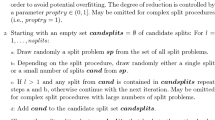Abstract
We extend the recursive partitioning approach to classifier learning to use more complex types of split at each decision node. The new split types we permit are bivariate and can thus be interpreted visually in plots and tables. In order to find optimal splits of these new types, a new split criterion is introduced that allows the development of divide-and-conquer type algorithms. Two experiments are presented in which the bivariate trees—both with the Gini split criterion and with the new split criterion—are compared to a traditional tree-growing procedure. With the Gini criterion, the bivariate trees show a slight improvement in predictive accuracy and a considerable improvement in tree size over univariate trees. Under the new split criterion, accuracy is also improved, but there is no consistent improvement in tree size.
Similar content being viewed by others
References
Sholom Weiss and Casimir Kulikowski,Computer Systems that Learn: Classification and Prediction Methods from Statistics, Neural Nets, Machine Learning, and Expert Systems Morgan Kaufmann: San Mateo, CA, 1990.
J.R. Quinlan, “Induction of decision trees,”Machine Learning vol. 1, no. 1, pp. 81–106, 1986.
Leo Breiman, Jerome H. Friedman, Richard A. Olshen, and Charles J. Stone,Classification and Regression Trees Wadsworth: Belmont, CA, 1984.
Robert Detrano, Cleveland heart disease data, Cardiology III-C V.A. Medical Center 5901 E. 7th Street, Long Beach, CA 90028. From the UCI Machine Learning repository.
W.Y. Loh and N. Vanichsetakul, “Tree-structured classification via generalized discriminant analysis,”J. Am. Statist. Assoc. vol. 83, no. 403, pp. 715–725, 1988.
Paul E. Utgoff, “Perceptron trees: A case study in hybrid concept representation,” inProc. AAAI, 1988, pp. 601–606.
Giula Pagallo, “Learning DNF by decision trees,” inEleventh Int. Joint Conf. Artif. Intell. vol. 1, pp. 639–644, 1989.
J.R. Quinlan, “Simplifying decision trees,” inProceedings of Knowledge Acquisition for Knowledge Based Systems Workshop, Banff, Canada, 1986.
Richard S. Forsyth, Bupa liver disorders, 8 Grosvenor Avenue, Mapperley Park, Nottingham NG3 5DX, 0602-621676, 1990. From the UCI Machine Learning repository.
B. German, Glass data, Central Research Establishment, Home Office Forensic Science Service, Aldermaston, Reading, Berkshire RG7 4PN. From the UCI Machine Learning repository.
Statlib, Liver disease diagnoses. From Carnegie Mellon University Statistics Library.
M. Zwitter and M. Soklic, Lymphography data, University Medical Centre, Institute of Oncology, Ljubljana, Yugoslavia. From the UCI Machine Learning repository.
National Institute of Diabetes and Digestive and Kidney Diseases, Pima Indians diabetes data, from the UCI Machine Learning repository, 1990.
Bojan Cestnik, Hapatitis data, Jozef Stefan Institute, Jamova 39, 61000 Ljubljana, Yugoslavia. From the UCI Machine Learning repository.
Chiharu Sano, Japanese credit screening (examples and domain theory). From the UCI Machine Learning repository.
Evlin Kinney, Echocardiogram data, The Reed Institute, P.O. Box 402603, Miami, FL 33140-0603. From the UCI Machine Learning repository.
Mary McLeish and Matt Cecile, Horse colic database, Department of Computer Science, University of Guelph, Guelph, Ontario, Canada N1G 2W1, mdmcleish@water.waterloo.edu. From the UCI Machine Learning repository.
Jason Catlett, Real-valued version of the multiplexor function. Private correspondence.
David W. Aha, Tic-tac-toe endgame database. From the UCI Machine Learning repository, 1991.
M. Forina, Wine recognition data. From the UCI Machine Learning repository.
M. Hollander and D. Wolfe,Non-parametric Statistical Methods Wiley: New York, 1973.
David J. Lubinsky, “Bivariate splits and consistent split criteria in dichotomous classification trees,” Ph.D. thesis, Department of Computer Science, Rutgers University, New Brunswick, NJ, 1994.
John Bentley,Programming Pearls ACM, New York, 1980.
Robert Messenger and Lewis Mandell, “A model search technique for predictive nominal scale multivariate analysis,”J. Am. Statis. Assoc. vol. 67, pp. 768–772, 1972.
David J. Lubinsky, “The use of additive split criteria in speeding up classification trees,” inFourth Int. Workshop Artif. Intell. Statist., Fort Lauderdale, FL, 1993.
Author information
Authors and Affiliations
Additional information
Much of this work was completed while the author was an employee of AT&T Bell Laboratories.
Rights and permissions
About this article
Cite this article
Lubinsky, D. Classification trees with bivariate splits. Appl Intell 4, 283–296 (1994). https://doi.org/10.1007/BF00872094
Issue Date:
DOI: https://doi.org/10.1007/BF00872094




